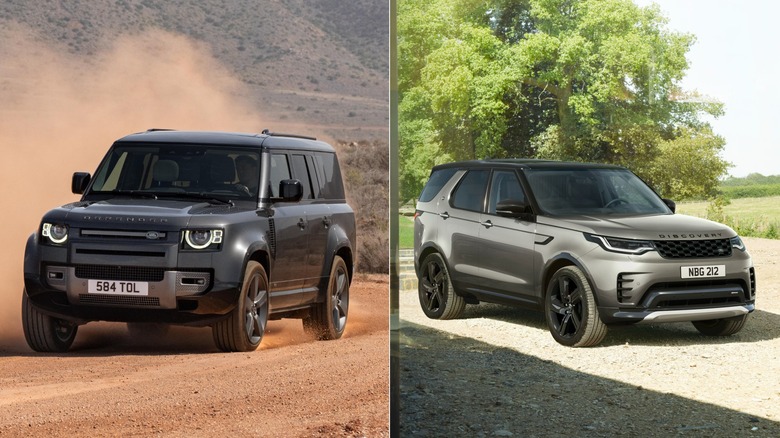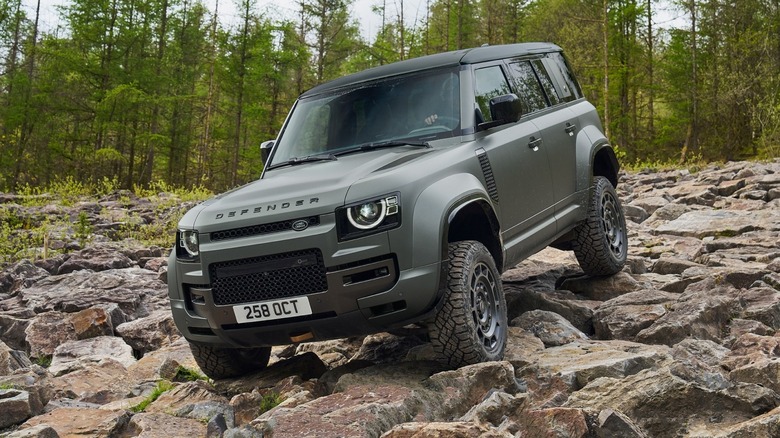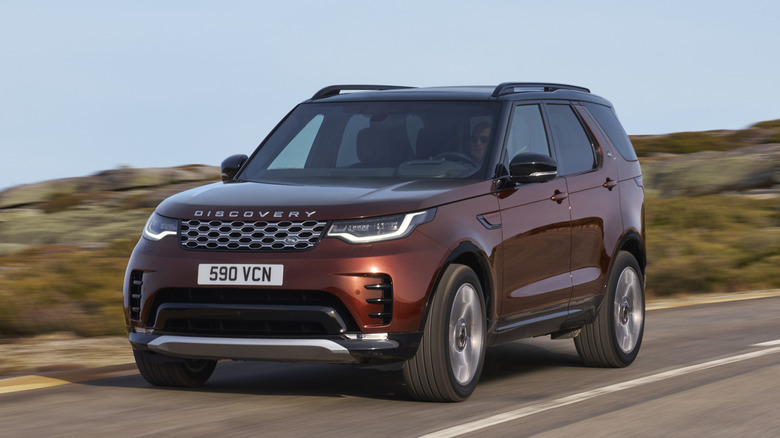Land Rover Discovery Vs Defender: How Do The Two SUVs Compare?
If you're in the market for a comfortable highway cruiser that's very much at home on off-road terrain, a Land Rover Discovery or Defender might make sense to buy. Both midsize SUVs come equipped with comfort-enhancing luxuries and boast rugged enough character to venture on off-road terrain quite a bit further than the average midsize SUV can dare to go. They're also based off the same D7 unibody platform, have the same engines, and share many more bits that can make deciding between them harder.
However, the two are different enough to cater to various tastes. The Land Rover Defender is offered in three body styles, the two-door Defender 90, the Defender 110 with two doors and two rows, and the Defender 130, an extended-wheelbase version with three rows of seating. Hence, it seats between five and eight occupants, depending on body style. The current-generation Discovery, meanwhile, is only available in three-row guise with space for seven occupants.
Between them, the sleeker Discovery is the one to pick if you're after a daily driver or drive mostly on paved roads, as it offers a smoother, more relaxing, and more refined ride experience than the boxy Defender, which, for its part, is a lot more suitable for off-roading due to its tougher stance and slightly higher maximum ground clearance of 11.5 inches, versus 11.1 inches for the Discovery. Below, we've compared the Land Rover Discovery and Defender in terms of their prices, power output, capability, and features to help make choosing the right model easier. This comparison is based on the 2025 Land Rover Discovery and Defender models.
The Land Rover Defender is cheaper to buy brand new than the Discovery
Given its starting price of $58,750, including a $1,850 destination charge, the Land Rover Defender 90 is $3,300 cheaper than the most affordable Discovery model, which begins from $62,050. However, base-spec Defender 110 and 130 models are priced higher than an entry-level Discovery at $62,650 and $71,550, respectively. Despite the price difference, the Defender and Discovery are equipped almost similarly in the base trims, with each model getting heated power front seats, a heated steering wheel and power tilt steering column, an 11.4-inch touchscreen that runs the brand's Pivi Pro software, Meridian audio system, a 12-volt power outlet, navigation, wireless charging, as well as Apple CarPlay and Android Auto.
While the Defender 90 has synthetic leather upholstery and dual-zone automatic climate control as standard in the 90 and 110 models, with three-zone climate control in the Defender 130 S, entry-level Discovery models are equipped with leather upholstery and three-zone automatic climate control. In addition to the plusher seats, the Discovery offers plenty of useful cargo room. Its area measures at 6.1 cubic feet with all seats in use, 35 cubic feet with the third row folded down, and 70.5 cubic feet with the second and third rows down. The Defender is more generous, providing between 10.5 and 15.3 cubic feet with all seats in place, as well as 58.3 and 78.8 cubic feet behind the first row.
The Land Rover Defender has a broader powertrain lineup
While the Defender offers five engine options, the Discovery offers two. In entry-level specifications, both vehicles feature a turbocharged 2.0-liter four-cylinder engine that develops 296 horsepower. If that's not enough, the Discovery offers an available turbocharged 3.0-liter inline six-cylinder, which has mild-hybrid technology to both boost fuel efficiency and minimize emissions. The engine produces 355 hp, and, like the turbo-four, directs power to all four wheels through an eight-speed automatic transmission.
The 3.0-liter mild-hybrid unit in the Defender, meanwhile, uses both a turbo and an electric supercharger to deliver 395 hp and 406 lb-ft. Beyond the inline-six, Defender buyers are looking at a supercharged 5.0-liter V8, available in outputs of 493 and 518 horsepower. The 110-based 2025 Land Rover Defender Octa improves upon those numbers with a twin-turbo 4.4-liter mild-hybrid V8 that puts out 626 horsepower and 553 lb-ft of torque. All Defenders come with an eight-speed automatic transmission and four-wheel drive.
Economy wise, the Discovery is the undisputed champion. Models with the turbo-four average up to 21 mpg, while versions with the inline-six engine are good for 19 mpg, according to the EPA. That's the same mpg figure as the most efficient versions of the Land Rover Defender turbo-four and inline-six engines. Of the Defender's V8 engines, the Octa's twin-turbo mill is the most fuel-efficient, with an EPA-estimated 17 mpg in combined city-highway driving. Defender models with the supercharged 5.0-liter V8 are rated at 16 mpg. Both vehicles have an almost identical towing capacity, with the Defender rated to tow 8,201 pounds max, while the can tow up to 8,200 pounds.


